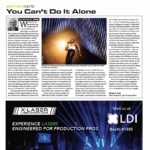I have always had an affinity for strobes. Ever since I got into this biz, I have been fond of all kinds of these fixtures and watched them grow in wattage from small Xenon gas discharged units to Lightning Strikes to LED models that are just blinding. Strobe lights originated in 1931 using flashtubes with energy supplied from a capacitor, similar to a battery, but capable of charging and releasing energy much faster.
They were used to mimic slow motion. By flashing a light source 20 times per second, the eye depicts the illuminated image like an old black and white movie where you seem to be missing frames. In 1983 I worked on the Talking Heads Stop Making Sense movie. Director Jonathan Demme wanted to use this exact effect during one of the songs. So they rented the best strobes in the business back then, Diversitronic’s analog 2K Xenon strobes with adjustable strobe rates.
The poor director was trying to get them all to strobe at the same rate of about four flashes per second and the gaffer spent days trying to get these to sync together for 30 seconds of film. They ended up renting every fixture they could find in LA to match the sync rate evenly among the fixtures.
I saw strobes used cleverly on a Pretenders tour in 1984. An LD named Clarkie had removed a Leko cap and mounted these Diversitronic models to the back of the ellipsoidal. He covered the rest of the exposed strobe face with black asbestos to prevent leaking. He now had a wicked white hard-edged strobe coming out of his conventional fixture that he could focus. If you check out this month’s Buyers Guide on strobes you will see that Diversitronic, the grandfather of all strobes in my book, has a strobe capsule designed to go into an ETC Source Four ellipsoidal.
You see strobes on airplane wings and buildings for anti-collision fixtures. Various official vehicles use them. Marilyn Manson once commented to his LD, Sonny Satterfield, that he particularly liked the red and blue chasing ones the Italian police cars had on their roofs. Somehow Sonny found two of these for sale, and I think they are still incorporated into Manson’s show.
High End Systems came out with the Dataflash back in the 90’s, and this was a rebirth in the concert strobe era. They were round and thermaled out, but they became common on shows. Around the same time, moving lights had strobe functions built into them. The first time I saw a High End Systems’ Studio Color fixture doing this “random strobe” effect, which I found breathtaking. While I do not think that moving lights strobing can ever replace a proper strobe fixture, a rig of lights in a white random strobe function looks cool.
Martin Professional then came out with the Atomic strobe. This game changer, with its xenon bulb fixture, ruled this market. I still know LD’s who refuse to use any strobe other than this one. Even if they have to mount a gel scroller to it. I saw some company mount a strobe on the end of a moving light. The strobes themselves were curved. I’m not sure how many people found them useful enough to use.
LED Strobes
The advent of the LED strobe has come to life. The fact is, you can slam these babies up at full in any color, in zero time, and they are just another big wash light. If you tell an LED to turn on and off 20 times per second, then it is essentially a strobe. Companies make these in the same size and shape as the original Atomic models now.
Solaris comes along and changed the game again by offering the consumer any type and sized strobe you could wish for. TMB carries five types of these, from Flares to Flare 2’s to the Mini Flare and the SoLED product; all LED models. The Quasar 15K model is a Xenon tube-based strobe with a 450,000-lumen output.
Special effects strobes are great. Star strobes are those dangling lights with a little capsule that go off randomly when AC is supplied. Rosco and Diversitronic make them. Finger strobes are something to check out as well.
I’m still waiting for a new strobe to come out that does things no other strobe has done before. But in the meantime, I’m digging on Blizzard Lighting’s new LoPro Flux. A circular par looking LED strobe whose face is broken into eight pie slices. Cool chases, bright enough effects and an unbelievably affordable price.
To view PLSN’s July 2015 Buyers Guide feature on strobes, CLICK HERE.
For Nook’s video introduction to the July 2015 issue of PLSN Magazine, CLICK HERE.


